
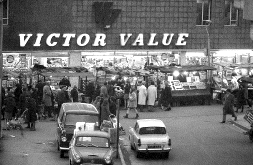

|
 |
|
 |
The 1950s saw the introduction
of 'self-service' shopping to Britain which completely changed the concept
of both shops and shopping as sales 'counters' were replaced by 'checkouts'.
Multi-product self-service outlets needed to be larger than traditional
bespoke shops and they also provided an increase in 'jobs for women' in
the form of checkout operators. Also, loose goods started to disappear as
items needed to be packaged to prevent their being handled by customers. In 1964, the abolition of Resale Price Maintenance prompted the rise of supermarkets. Resale Price Maintenance (RPM) obliged shops to sell goods at standard prices set by suppliers, and thus prevented the search for better business through undercutting. This helped small independent shopkeepers in their resistance to larger traders. Abolition of RPM opened the way to the rise of supermarkets and the transformation of the retail industry. Morrisons was founded by William Morrison in 1899, starting as Wm. Morrison Limited, selling butter and eggs in Rawson Market, Bradford. His 21 year old son Ken took over in 1952 and opened a small shop in the city centre in 1958. The store had three check-outs, was the first self-service store in Bradford and also the first store to put prices on its products. They opened their first supermarket, called 'Victoria', in 1961 in Bradford's Girlington district in a converted 5,000 sq. ft. cinema, with free parking. Morrisons became a public limited company on the London Stock Exchange in 1967. In 1929 the Lipton Tea Company merged with Home and Colonial to form 'Home & Colonial', a grocery chain with more than 3,000 stores. It continued to trade under this name until 1961 when it became Allied Stores, which was owned by Unilever. Associated British Foods, manufacturers and retailers of food, bread and provisions were founded in November 1935 by Willard Garfield Weston. Initially known as Food Investments Limited, the name was changed to Allied Bakeries Limited a month later when it converted into a public company after acquiring 14 bakeries. The company merged with subsidiary Weston Foods in 1939 and changed its name to Associated British Foods in 1960. ABF acquired A. B. Hemmings Bakeries in 1961, the leading high street store Fine fare in 1963 (sold in 1986) and Twinings in 1964. The Fine Fare chain of convenience stores had started as a single supermarket in Brighton in 1956. The Premier and Victor Value convenience store chains were also established during the 1950s. |
| As
a result of staff shortages caused by the war, LCS, the London Co-operative
Society, set up the first UK self-service store in Romford (occupying 176
sq. ft.) in 1942 using old second-hand shop equipment. LCS opened the first
full self-service store in Upton Park in 1948, more properly equipped. The
first UK 'supermarket' (occupying 2,250 sq. ft.) and with three checkout
counters was opened by Express Dairies at Streatham Hill in 1951. Although
several of the LCS self-service food stores were of a comparable size, they
were not operated in a true 'supermarket' fashion. ASDA's origins can be traced back to a group of Yorkshire farmers who formed Hindell’s Dairies in the 1920s. This group expanded and diversified to became Associated Dairies and Farm Stores Ltd. in 1949. In 1958 two brothers, Peter and Fred Asquith, opened a supermarket in Pontefract and within five years they had a chain of self-service supermarkets called Queen’s Supermarkets. The two companies merged in 1965 and the acronym name ASDA was adopted with AS standing for Associated and DA for Dairies. The new company bought the GEM chain in 1965 and re-launched them under the Asda Queen name. In 1968 Associated Dairies bought out the Asquith Brothers and the company acquired two failing US discount stores to form a larger retail business with sales at their new Nottingham store increasing from £6,000 to £30,000 in their first week. By the end of the decade ASDA had developed its own brand range and operated 30 stores in the North of England, expanding southwards. In 1950 Gateway Foodmarkets (later Somerfield) was developed from the Bristol-based J. H. Mills group of 12 family grocers originally founded as a single store in 1875. In 1964 the wholesale part of the business was taken over by Frank Dee who had 70 'Frank Dee' supermarkets in the North of England and the DEE Discount stores. |
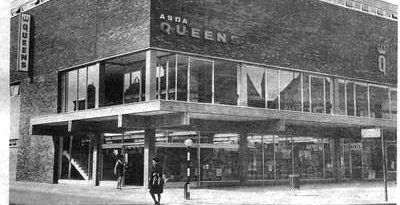 |
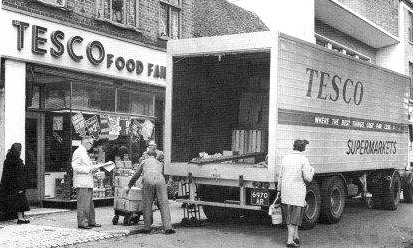 |
In
1970 Frank Dee become part of the Linfood Holdings Group that took over
Gateway in 1977, increasing the number of Gateway stores to 100. After
a complicated series of acquisitions and mergers the company was taken over
by the Co-operative Group in 2009, creating the UK's fifth largest food
retailer. Tesco, as a group of
market stalls in Hackney, London, was founded
by Jack Cohen in 1919. The Tesco name first appeared in 1924 when Cohen
purchased a shipment of tea from T. E. Stockwell and combined their initials
with the first two letters of his surname.
The first Tesco store opened in Burnt Oak, Middlesex, in 1929 and by 1939
there were more than 100 Tesco stores throughout the country.
Following a research visit to North America, the first Tesco self-service store was opened in St. Peters Street, St Albans, Herts. in 1956 (right) and it remained operational until relocating to larger premises further along the road in 2010. Their first 'supermarket' appeared in Maldon in 1956 after which the company steadily expanded, acquiring the shops of a number of rival companies. In 1957 they bought 70 Williamson's stores, followed by the purchase of 200 Harrow Stores outlets in 1959 and 212 Irwins stores in 1960. In that year Tesco opened an outlet in Cheltenham with an unprecedented 4,200 sq ft selling space followed, in 1961 by Tesco Leicester which, with 16,500 sq ft of selling space, entered the Guinness Book of Records as the largest store in Europe at that time. In 1968 the company purchased the Victor Value chain (a London-based supermarket group of 217 stores that included some former Anthony Jackson Foodfare outlets) bringing their total number of stores to over 800. Tesco converted some of the larger branches to their own brand, name but did not integrate the rest of the chain, which was sold to Bejam in 1986 to form a specialist chain store set up to sell only frozen foods. Also in 1968, after discussions with Tesco, resulted in the development of the UK's first trade-approved electronic Retail Digital Scale, which was passed for use by the Board of Trade on 10th July. During the early 1960s, Tesco lobbied Parliament to have RPM (Resale Price Maintenance) abolished. This constriction prevented major retailers, who could buy in bulk, from undercutting the prices of smaller shops. During this period, chain stores such as Tesco and the Co-Op got around this by issuing trading stamps with purchases, which could be redeemed for catalogue goods, effectively providing a customer 'discount'. In 1964 Parliament passed the Resale Prices Act, abolishing RPM except for particular items such as books and pharmaceuticals. |
|
1958 had seen Green
Shield Stamps being launched by Richard Tompkins, based on an
American concept. In 1963 Green Shield stamps were adopted by Tesco, who
saw it as a significant traffic builder and a way around RPM. With the abolition
of RPM, competition from other companies and major changes in consumer 'rewards',
Richard Tompkins changed the Green Shield Stamps catalogue stores (where
stamps were redeemed for products) to Argos, the retail catalogue outlet,
in 1973. Green Shield eventually suspended operations in 1983 but not finally
discontinuing their stamps until 1991. In 1959 Albert Gubay (right) opened
his first 'Value Foods' shop in Queen Street, Rhyl, followed by other outlets
in Wrexham and Chester. After studying German and American discounters he
realised the key was to buy limited lines of stock on long payment terms,
sell at rock-bottom prices and use positive cash flow to keep the business
growing, so he adjusted his business model to suit. He opened the first of his larger 'Kwik Save' stores in 1965 at Colwyn Bay and it rapidly became a fast-growing chain, eclipsing Value Foods, and was floated on the stock market in 1970 with Gubay retaining 45 per cent of the business. By 1971 he had 45 stores in the north of Britain. He subsequently initiated the '3 Guys' supermarket chain in New Zealand which built up a 30 per cent market share and, four years later, took the format to Ireland where he sold out to Tesco. He also started the Total Fitness gym chain which he sold for £80 million in 2004. Gubay died in January 2016. Mothercare was first opened on 14th September 1961, founded by Selim Zilkha, an Iraq-born entrepreneur who served in the U.S Army during World War 2. He bought out the 50-store W.J. Harris nursery furniture chain and renamed it Mothercare, eventually expanding it to over 400 outlets. Zilkha sold his interest in Mothercare in 1981 and moved back to America. Sainsbury's was founded in 1869 by John James Sainsbury and his wife Mary Ann Sainsbury in London. It has since grown to become one of the UK’s largest retailers. In 1961 they became the first food retailer to computerise distribution and, during the Sixties, Sainsbury's saw the number of its offerings of food products double from 2000 to 4000. |
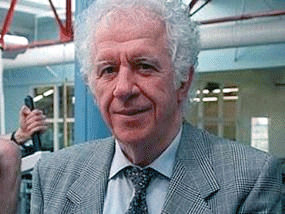 |
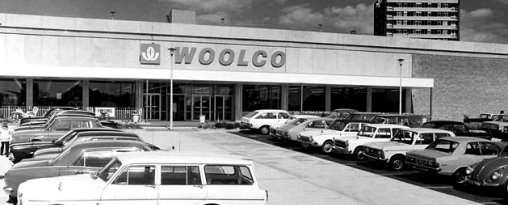 |
Woolworths
experimented with some large 'out of town' stores in a hypermarket format
called 'Woolco' in the 1960s. (Hatfield Woolco, left). In 1963 Richard Block
and David Quayle set up the first 'B&Q' hardware store, based in a derelict
cinema in Portsmouth. The group was acquired by Woolworths in 1982 as part
of their chain expansion plan. The first UK 'superstore' (although not advertised as such) was opened by GEM, in November 1964, in West Bridgford, a town in the Rushcliffe borough of Nottinghamshire. Gem International Supercentres Incorporated was an American-owned company that aspired to export U.S. shopping practices to Britain. The British public had never set eyes on anything quite like it, consisting of a vast 110,000 sq. ft. of floor space and containing an amazing array of hardware, groceries, clothing and furniture all under a single roof.It contained some 50 separate departments including a pharmacy, sports items, music and records, a restaurant, children's toys, a hairdresser, shoe repairs and carpets. The stock and shop fittings were reportedly worth over £700,000 - an unimaginably large amount for the time. On its opening weekend an estimated 30,000 people and 5,000 cars visited the store (causing traffic jams for miles around as there were only 1,000 parking spaces). Although a reasonably successful novelty, it was bought up by Associated Dairies in 1966 and, as ASDA, the concept was developed much more successfully than GEM had previously done. The first purpose-built indoor shopping centre, The Bullring Centre, covered 23 acres and was opened in Birmingham in 1964 at a cost of £8million. It was a combination of outdoor and indoor markets (the indoor market housed 1250 stalls), and an indoor shopping centre containing 140 stores occupying 350,000 sq. ft. Designer Terence Conran opened his first Habitat store at 77 Fulham Road in Chelsea in May 1964, offering a plethora of colourful, well-designed products that encapsulated the new and exciting 'feel' of the Sixties. |
| Also in 1964, Barbara
Hulanicki started her Biba empire as a mail order company. Its first major
success came in May of that year when it offered a pink gingham dress to
Daily Mirror readers. A similar dress had been worn by Brigitte Bardot and,
by the following day, over 4,000 orders had been received. Some 17,000 outfits
were ultimately sold. In September 1964 Biba opened its own store in Abingdon
Road in Kensington with its well-known combination of art nouveau and art
deco styles. A second store at 19-21 Kensington Church Street opened in
1965 and the large department store in Kensington High Street opened on
16th September 1969. The first commercial use of bar-coding occurred in 1966 but, without an industry standard, it was not widely adopted until the end of the decade. By 1970, the Universal Grocery Products Identification Code (UGPIC) had been developed by Logicon Inc. and the first company to produce barcode equipment for retail trade using UGPIC was the American company Monarch Marking with the British company Plessey Telecommunications developing a system for industrial use.On 29th June 1966 Barclays Bank introduced the first UK credit card, Barclaycard, but it was a considerable time until it was generally accepted by most retailers. In 1967 Laura Ashley opened her first shop in Kensington. Tesco first used the term 'superstore' in 1968 to describe their new shop in Crawley that sold food and other goods on its 3720m2 floor. New Look opened its first store in Taunton, Devon, in 1969, being one of the first stores to offer imported clothing at bargain prices - known as 'fast fashion'. The first real 'out of town' shopping complex, with a sales area of 54,000 sq. ft. was opened in 1971 at The Flaxland Bretton Centre, near Peterborough. |
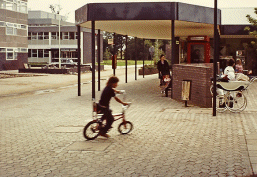 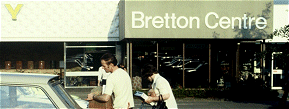 |
|
|
All
Original Material Copyright SixtiesCity
Other individual owner copyrights may apply to Photographic Images |